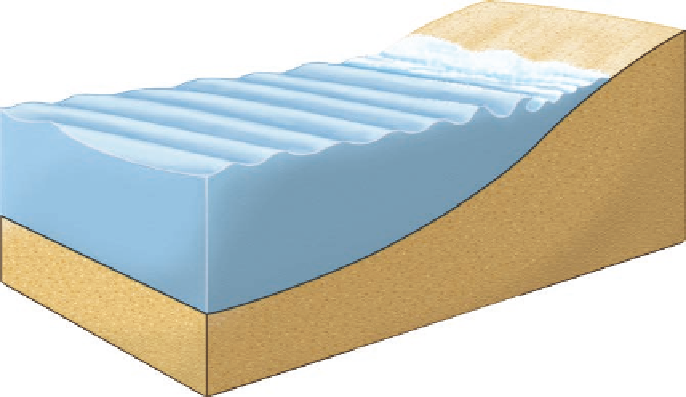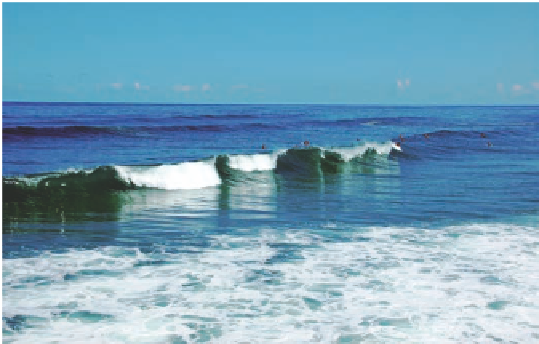Geoscience Reference
In-Depth Information
As waves approach the coastline, they begin to encoun-
ter shallower water because the seafloor gradually slopes up-
ward to the shore (Figure 19.10). At some point, the water
depth becomes sufficiently shallow that the wave base and
the ocean bottom intersect. From this point forward, the ver-
tical space in which the rotating water has to move becomes
progressively restricted, causing the overall wave height to
increase and the overall speed of the waves to slow. At the
same time that the forward speed of the waves is decreasing,
from the point where the interaction of the wave base and
ocean bottom begins, additional waves continue to advance
into the area, resulting in compressed wavelengths as more
waves crowd into a smaller space. Ultimately, the height of
each individual wave exceeds its vertical stability, and the
wave crashes in a feature called a
breaker
. This point typical-
ly occurs when the wave height is about seven times greater
than the wavelength. From the time the wave breaks onward,
the forward momentum of the wave causes water to rush onto
the beach as
surf
, which is the only part of the wave system
where water is actually moving forward, instead of up and
down. In places that are typically sheltered from waves in
some fashion, or have a short fetch, a sudden increase in wave
energy can cause erosion and significant modification of the
coast. On the other hand, many other coastlines are consis-
tently influenced by strong waves and are thus in equilibrium
with no net erosion or deposition of sediment due to high
wave energy.
Littoral Processes and Sediment Transport
Let's
now take a closer look at wave/shore interactions and how
they affect the way that sediment is transported along the
coast. These interactions depend on many factors, including
the shape of the coastline, the direction and seasonal varia-
tion of prevailing winds, intensity of waves, tidal range, and
the nature of coastal sediment, to name but a few. In some
places sediment moves freely along straight coasts for great
distances, whereas in others it can be trapped in nooks and
crannies along the shore after moving only a short way. As
you might imagine, the various combinations of these factors
can result in myriad interactions, most of which are far be-
yond the scope of this text.
Perhaps the most simplistic and commonly considered
way to view these interactions is to observe what happens
on a relatively straight coast when waves approach at some
kind of angle (Figure 19.11), as they do in many places.
Because of this oblique approach, the force of the water
Breaker
A wave that rises and crashes when the forward
momentum of oscillations cannot be maintained.
Waves become
higher, shorter, slower
Breakers
Surf
Beach
Strong sediment
transport-erosion
and deposition
Shallow
water
Deep
water
(a)
Loops deform
from friction
with seafloor
Loop-like
oscillations
of water
Figure 19.10 Wave formation and components.
(a) Waves
have a distinct structure that is driven by circular movements of
particles of water. Waves crash at breakers when the wave height
exceeds the vertical stability of the wave. (b) A breaking wave
along the Outer Banks of North Carolina. This pattern occurred
because the wave height exceeded the vertical stability. Note the
pair of incoming swells in the background and the surfers waiting
to catch a great wave.
(b)































